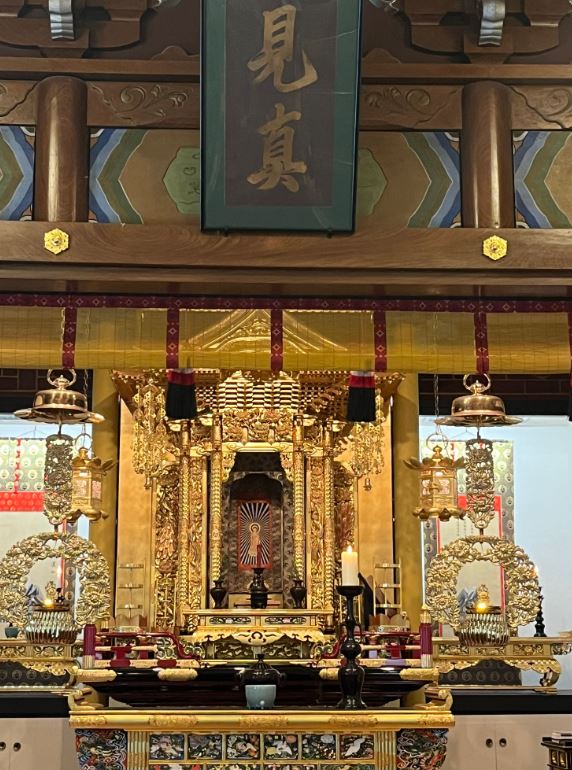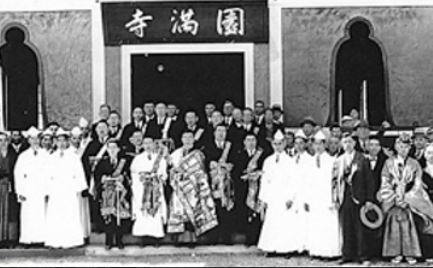By Jeanne Mariani-Belding
(This is part of our ongoing series, Lost Kinjo– a look at the more than 40 Japanese communities that disappeared after World War II. It is supported by funding from the California Public Library Civil Liberties Project and the Takahashi Family Foundation.)
Sebastopol is tucked in a corner of western Sonoma County, a blend of rural plots and emerging hipster culture. But if you take a deeper look, Sebastopol also had a thriving Japanese American community prior to the second world war, many of whom were farmers, producing apples, grapes, poultry and more; a place where the Enmanji Buddhist Temple was buzzing with kids, culture and a deep sense of community.
Before the war, Japanese Americans in communities like Sebastopol felt the promise of opportunity and saw the fruits of their hard work. Indeed, Japanese American farmers produced roughly 40 percent of all vegetables grown in California and almost all of its peppers, tomatoes and strawberries.

The war and the incarceration of Japanese Americans changed that, and so much more. It shook their sense of safety and belonging; took away their land and their livelihood; and forced many of them to start over. And over time, the community saw its numbers decline. Enmanji temple’s membership that once numbered in the hundreds, shrank to about 100 today, its leaders say. Similarly, the Sebastopol-based Sonoma County Japanese American Citizens League (JACL) has seen its membership drop to just about 100 as well.
But this is a resilient community. And in story after story, the dark period of incarceration of Japanese Americans also illuminated the kindness of neighbors, many of whom kept watch over their homes and property, hopeful that they would return. Time has faded many of those memories—survivors who were young children at the time are moving quickly through their 80s and 90s.
“A long time ago in the 1930s there was a large Japanese community. But in those days, they stayed together as a group. These days the children are not as interested in the Japanese community, they’re interested in the greater community,” said Ray Yamasaki, 84, who was granted lifetime board member status and the position of advisor at Enmanji temple. He and his family were among the more than 120,000 Japanese and Japanese Americans incarcerated as part of the racist hysteria surrounding World War II. Along with other Sonoma County Japanese Americans, they were forcibly sent to Amache prison camp in Granada.
“I know Japanese American young people who didn’t even know this happened. It didn’t affect their lives and their parents never really talked about it. It’s as if this happened 500 years ago,” Yamasaki said.

The Sonoma County JACL has several programs to preserve the memory of that shameful period in history. But perhaps its most moving effort has been its oral history project, which includes first-hand accounts of the incarceration from many of Sebastopol’s Japanese Americans who have since passed away. The project was compiled in a book titled Giri, which was digitized by Sonoma State University.
One of those first-hand accounts is from James Murakami, who was imprisoned at Amache at just 15, along with his family. In today’s divisive political climate, his cautionary words feel prescient. He died in 2012.
“We should not judge people collectively as a group. We judge them individually and for what they are, and not collectively. And that’s the biggest lesson I think we can learn from whatever has happened to us and we’ll try to prevent that from ever happening again. But as I say, history has a nasty tendency to repeat itself,” Murakami said in a videotaped interview.
Murakami’s son, Alan Murakami, remembers his father’s post-war resilience well. He recalled how his father, who earned his high school diploma at Amache during the government-imposed incarceration, could not get into college because his diploma was not from an accredited high school. His father went to night school, earned his diploma, and received a degree in mechanical and electrical engineering from University of California, Berkeley.

Alan Murakami said his dad worked his way up the ranks of the JACL, eventually becoming national president in 1976-78, and was part of a group of Japanese American leaders who were instrumental in having the Civil Liberties Act of 1988 signed by President Ronald Reagan and Congress.
“I believe that the incarceration touched him in a way that perhaps awoke and then strengthened his resolve and advocacy for redress,” Alan Murakami said of his father.
The younger Murakami remembers both his father’s and his mother, Margarette Murakami’s stories about Amache. He also wrote a book about his uncle, Peter Masuoka who, while imprisoned in Amache, enlisted in the U.S. military and served in the storied 442nd Regimental Combat Team. A year after President Franklin Roosevelt signed Executive Order 9066, ordering the imprisonment of West Coast residents of Japanese descent, most of whom were U.S. citizens, he activated the 442 nd team—the most decorated unit in U.S. military history for its size and length of service. Masuoka was killed in service in France and the Enmanji temple dedicated its memorial hall, in part, to him.
Alan Murakami said the size of Sebastopol’s Japanese American community has become much smaller since the war, with fewer Japanese American youth and fewer events. “Even though there are less and less Japanese Americans here, the people who are still here though are very similar to our parents and our grandparents. We value community and we value the support we all get from each other when we have challenging times,” said Murakami, who lives across the street from the Enmanji temple.

Darryl Yagi, a minister’s assistant at Enmanji, said membership has dropped significantly and the temple has not had a resident minister in more than a decade.
“Gradually the numbers declined, just like other religious institutions. A lot of the members were elderly, the temple had members in their 100s and 90s, so there’s a number who have passed away over the years,” Yagi said.
The Sonoma County JACL now opens only by appointment. Educating the broader community about the Japanese American experience, including the incarceration, is an important part of the center’s work. It includes a program for elementary school-aged children through kamishibai, a form of traditional Japanese storytelling and street theater using paper illustrations and narration. It uses the experiences of those who were incarcerated and historical facts to create a fictional story that children can understand. It talks about how families were uprooted and had to leave their pets, toys and friends behind—unsure of where they were going or when they would return, said Sachiko Knappman, who performs kamishibai in schools and serves as the JACL’s vice president of membership.
“We all need to realize what we have is fragile. It’s not etched in stone. It can be easily taken away,” she said. “Freedom, the right to organize. We have to have numbers to fight injustice. This kind of organization keeps its eyes and ears open and informs us on what government is doing.”
(About the Author: Jeanne Mariani-Belding is an award-winning former journalist and Pulitzer Prize judge. She is a Stanford University John S. Knight journalism fellow and served as national president of the Asian American Journalists Association.)
AsAmNews is published by the non-profit, Asian American Media Inc.
We are currently funded by our readers and such charitable foundations as the Robert Wood Johnson Foundation, AARP, Report for America/GroundTruth Project & Koo and Patricia Yuen of the Yuen Foundation.’
Find additional content on Bluesky, Facebook, Instagram , Tiktok, X, and YouTube. Please consider interning, joining our staff, or submitting a story, or making a tax-deductible donation.
You can make your tax-deductible donations here via credit card, debit card, Apple Pay, Google Pay, PayPal and Venmo. Stock donations and donations via DAFs are also welcomed. Contact us at info @ asamnews dot com for more info.



My father was born at Amache in 1943 (he was 6th child of the Otani family). Most of my family were from Cotati and Petaluma. Dad passed in 1997. Im profoundly deaf and my younger sister is, too. Im in Santa Rosa and remember going to Enmanji Temple for Dad’s memorial. This needs to be preserved for the future.